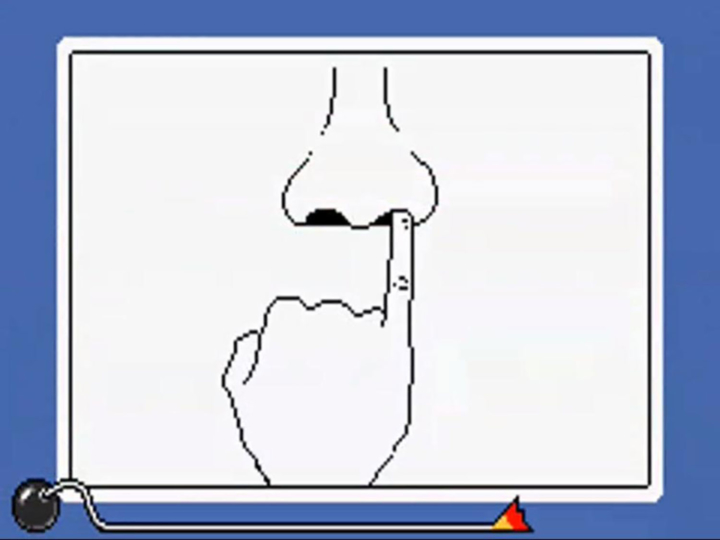The Glaswegian artist Gregor Wright once mentioned an idea he had for a video game for the Commodore 64 called Jetpack Fantasy. The objective of the game was to earn money from mowing lawns in order to save up to pay for a jetpack. Maybe after a bunch of mowing levels, you’d have enough money for a short go on the jetpack. Mowing the lawn and riding the jetpack, however, would be virtually identical from both a mechanical and aesthetic viewpoint. The background would now be sky blue instead of grass green, but the movement inputs would remain exactly the same.
Wright had broken down two elements of game design to their most basic building blocks. First, Jetpack Fantasy asks how similar two clearly opposing facets of play — grinding and reward — can be made. While the game offers the illusion of reward, an impossible stretching of the imagination would be required to find the jetpacking any more rewarding than the mowing. The two activities have little to do with one another, but when simulated on a Commodore 64 and reduced to a few simple button inputs they become virtually indistinguishable. For one to have a higher value than the other requires the player to take a purely subjective stance.
But Jetpack Fantasy raises another very simple question with no one correct answer: What is the best way to implement an action in a game?
While jetpacking and mowing may be simulated through identical inputs when performed on a rudimentary thirty-six-year-old computer, it is safe to assume that that this bears no resemblance to the actual act of pushing a lawnmower or operating a jet-powered device on one’s back.
Assigning tasks to a player and organizing how these are implemented through player control is a fundamental challenge for the game designer. Things need to be done, and there are a great number of ways to do them. Should boring things be fun? How easy should a hard task be? How do we make this feel different from that while using the same buttons? And where do we draw the line? Should walking require a button for each foot?
Take, for example, the art of picking locks. In many sorts of games, players may find themselves confronted with a locked door, chest, or safe of some description. How one opens these locks can vary wildly from game to game, but broadly speaking it will fall into one of two categories. Sometimes it resembles the actual procedure of picking a lock or hacking a security system, a technically comparable solution in which locks may have tumblers that require gentle manipulation, computerized systems might require passwords or code breaking. Alternatively, the game designers may have you do something that in no way resembles the specific task at hand but which is also difficult or inconvenient. This could be tediously pressing one button for some length of time, leaving you vulnerable and unable to move. Or maybe it will involve a “quick time event,” requiring the player to press a sequence of buttons with split-second precision. Sometimes this will actually be a mini-game in its own right, a puzzle of some form that stands in for the act of lock picking. Beat the mini-game and open sesame.
The Yakuza games (Sega, 2005–present) excel at finding ways to faithfully simulate wonderful and bizarre pastimes on offer outside of the work of Yakuza-ing. Should you find yourself in the gym, for example, each exercise will be performed in a slightly different manner and require diligent attention: the action for a push-up is quite different from a pull-up. When bartending, each step of mixing a drink is closely approximated in the necessary player inputs. From fishing to karaoke, great attention and respect is given to each procedural element of every action.
The opposite approach is taken by the WarioWare games (Nintendo, 2003–present), in which all activities are reduced to a single button input. Each WarioWare entry is a schizophrenic collection of hundreds of micro-games, each about three seconds in length. Jump, walk, bite, scratch, run, duck, pick, and pluck are typical one-word prompts that guide players as they find themselves thrown into new scenarios. The input is almost always the same — press A — however the precise manner in which one must press A differs depending on the action. And each action — pump a tire, pick a nose, pop a balloon — occurs so quickly the player is constantly shifting attention; thus WarioWare makes a repeated gesture feel perpetually new through disorientation
A major component of the question of configuring controls is: How does the controller correspond to the body? A very rough anatomic accordance can be made with the control pad. It has a left half and a right half, a top and a bottom, and four face buttons that could be assigned to the limbs. Some 3-D fighting games apply this logic and become more fluid as a result. Understanding how each button relates to parts of the body creates a deeper connection than simply seeing moves as strings of complicated button inputs.
Thrasher Presents Skate and Destroy (Rockstar Games, 1999) was an ugly and clunky game that surprisingly managed to very accurately replicate something of the essential activity of skateboarding. The fundamental logic of how tricks are performed was transposed to the PlayStation control pad with great consideration. Released the same year, Neversoft’s Tony Hawk’s Pro Skateboarding was an altogether slicker affair that was aiming for much wider appeal — which it achieved far beyond anybody’s expectations. Its success was due in part to how little it had in common with actual skateboarding, having virtually no concern for the limits of what can conceivably be performed on a skateboard. Skateboarders might see Thrasher as a superior game due to its punishing realism, steep learning curve, and strict adherence to the foundational logic of skateboard tricks which informed the control scheme. But the cartoon physics and inconceivable tricks of the Tony Hawk series proved hugely popular, and the game spawned numerous sequels and spin-offs.
Of course, many would say that these are all stylistic decisions, and that it all comes down to the type of game — unrealistic fun or a serious replica of the real world, a distinction often framed by the opposing categories of arcade vs. simulation. But this opposition is an oversimplification. The three games in the Skate series (EA Black Box, 2007–10) achieved both significant crossover appeal and the love of skateboarders by skillfully combining the accessibility of the Tony Hawk games with a control scheme akin to that of Thrasher. What is more, a mainstay among the distractions found in the Yakuza games is the ability to play classic arcade games in a perfect simulation of a SEGA arcade. Sometimes a game may benefit from being a bit of both.


